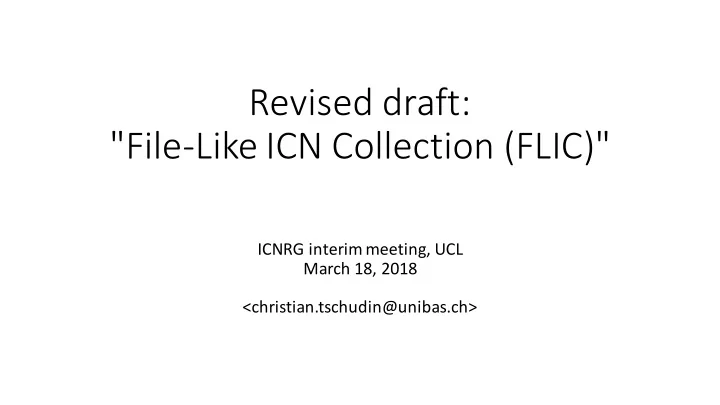

Revised draft: "File-Like ICN Collection (FLIC)" ICNRG interim meeting, UCL March 18, 2018 <christian.tschudin@unibas.ch>
In this presentation a) FLIC in one picture b) Different motivations why people may use FLIC: packet trains vs huge data collections c) Four motivations for a revised draft: 1. Encoding strategies 2. Separate DEK and SEK ( D ata vs S tructure E ncryption K ey) 3. Implementation complexity of FLIC en coding 4. Implementation complexity of FLIC de coding
Manifest1 a) FLIC in one picture Manifest0 Data0 Data1 Data2 Data3 • Large data is cut into chunks, persisted independently • Manifest packets contain: metadata, index table(s), signature. Are also persisted. • Index table contains “hash pointers” (incl intrinsic name of data or manifest chunk) • Manifests as an alternative to chunk naming , even have “name-less objects”
b) Differences in why people may use FLIC • Transient use: - send several signature-less data chunks - manifest with a single signature covers all chunks, less run-time effort • Permanent use: - ICN as a global block storage service (PDU == block) - large data collections then mapped to ICN blocks - collection examples: a file, DB table, append-only log, other hash-chained data structures
c.1) Revision b/c of encoding strategies Seminar students pointed out that B-trees are better (than a transport- optimized manifest encoding) for storing video: we want to “seek” • “transport-optimized” means: A manifest has multiple data pointers to fetch top manifest before one has to fetch another manifest top manifest This shape forces to fetch all manifests before Immediate access to first chunk, we being able to access can pre-fetch 2 nd manifest in parallel. the first chunk. Goal for draft: better describe trade-offs and preferences for tree shapes.
c.2) Separate DEK and SEK End-to-end encryption and access control in ICN: • source encrypts content with a DEK (data encryption key) • access is controlled by selectively handing out the DEK Should manifest packets be encrypted, too? à Use a different SEK ( structure encryption key) • Permits to delegate operations on the tree to third parties, edge nodes, without exposing the (DEK-protected) data Goal for draft: introduce SEK, perhaps also “ptr to encrypted manifest”
c.3) Encoding complexity (shape of the tree) From PyCN-lite: easy to write a default tree encoder But encoder needs data structure awareness: • “log file” case: append-only of text lines bad: append a new manifest to old manifest, plus link to new line good: transport-friendly reshaping of the previous tree (WITHOUT link to the previous manifest!) Goal for draft: better discussion of encoding strategies, data structure awareness
c.4) Decoding complexity (metadata) How useful are the proposed FLIC metadata fields? Ex: pos and # of bytes in a sub-tree Became wary when writing FLIC decoders (= tree traversers): packets control my effort. - accidentally wrong metadata (byte position for seeking MUST be accurate) - deliberate wrong metadata “Be conservative in what you send, be liberal in what you accept” a. Drop most of metadata? (Manifest consumer has to verify a lot, has to guard against DoS attacks - at the end the SW is perhaps not better off, compared to not having this information at all.) b. Introduce "attestation" of manifest content, by third parties? Goal for draft: eliminate all metadata fields having usefulness concerns.
Recommend
More recommend